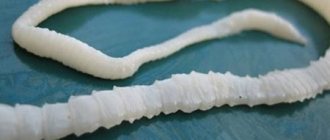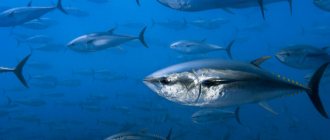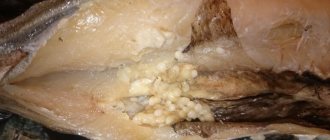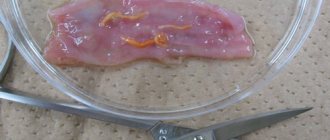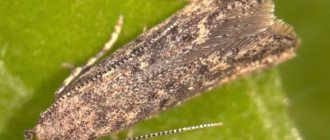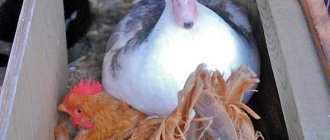Any housewife knows that improper processing of food can lead not only to a deterioration in the taste of the dish, but also to health problems for those who eat this dish. For example, fish often contains various worms, which are quite dangerous for humans to eat.
To avoid unpleasant consequences, you need to know how to determine the presence of parasites and how to properly process and cook fish.
Types of parasites
Various worms can be found in live fish. It is very useful to know what parasites look like, how they can be detected, which of them pose a serious threat to human health, and which are practically harmless.
Wide tapeworm
These helminths are quite common in fish. The parasite belongs to a type of flatworm, a class of tapeworms. It can reach a size of several meters. In fish, it is most often found in the liver or muscles. In the human body it parasitizes in the small intestine. The disease is caused by diphyllobothriasis.
Tapeworm
Cat fluke
The parasite, which belongs to flatworms, begins its development in the body of freshwater snails. Then it leaves the host’s body and, once in a reservoir, enters the fish’s body, where it develops in muscle tissue. Often found in carp, carp, roach, and cod. Once in the human body, it grows, releasing toxins in the process of life, which causes the patient’s immunity to decrease and their general well-being to deteriorate.
Beltworm
Ligulidae is also called tapeworm. This white worm develops in the abdominal cavity of the fish. As it grows, the internal organs of the fish are increasingly compressed, which causes a disruption in their normal functioning.
On a note! Due to damage to the swim bladder, fish often cannot dive into the water and float on the surface.
As a result, the infected individual stops growing. These worms are most often found in pink salmon, bream, and rudd.
Schistocephamos and phylometra
Schistocephamos is a worm from the genus trematodes. This is a small worm, similar in appearance to a tapeworm. Most often they parasitize smelt or crucian carp.
Philometra are thin red worms reaching a length of 10–15 cm. Most often they parasitize on the scales in the head area, under the gills.
These parasites in fish are not dangerous to humans.
Trienophorus nodulosus and Cystidicolafarionis
Trienophorus nodulosus are helminths that live in the liver of fish (most often burbot). Recognizing the parasite is quite simple. The worm itself is 7-8 cm long and lives in a capsule in the form of a small light ball. After careful removal of the liver, the fish is absolutely safe for humans.
Cystidicolafarionis - parasitizes the swim bladder of river fish, such as perch, pike perch, and smelt. During the cleaning process, the fish's innards are removed, after which the product can be eaten without harmful effects on health.
Anisakid
These helminths are nematodes and most often infect marine fish. They can be found both in the body cavity and in muscle tissue, most often in a coiled state. Worm larvae, depending on the species, are yellowish or red in color. Once in the human body, fish worms penetrate the digestive tract, where they attach to the mucous membrane, provoking the development of an inflammatory process.
Safe types of parasites
Some types of worms that parasitize fish do not pose a danger to humans. These varieties include:
- diplostoma (flatworms) - mainly affect the gills, eyes, pectoral fins;
- polymeters (roundworms) - in males they parasitize inside the swim bladder, in females in scaly pockets;
- several types of tapeworms, including the common Ligulidae , a white worm that lives in the stomach of fish.
Worms in fish
These helminths are not parasitic in the human body. Moreover, if the fish is properly cleaned before cooking, all parasites will be removed.
The most susceptible fish species to infection
Although any fish can be infected with worms, some species are more susceptible to infestation. For example, parasites are found much more often in river and lake fish. The varieties most susceptible to parasite infestation include:
- crucian carp;
- perch;
- ide;
- bream;
- tench;
- pollock;
- flounder.
Depending on the type of parasite, fish may contain eggs, larvae, or adults. Preparing dishes from fish, which is likely to be contaminated, requires particularly careful cleaning and high-quality heat treatment.
Signs
There are a number of signs by which a person can determine that fish is infected:
- The product is soft to the touch, dents quickly disappear when pressed with a finger.
- The pupils are cloudy, the mucous membrane of the eye is dry, and black spots can be visually seen.
- The skin of the fish under the scales is sticky.
- The abdomen is swollen and elongated.
- The gills are green in color.
- Unpleasant smell.
The patient will have to give preference for purchases to those stores where the fish undergoes a thorough sanitary inspection. Preventive measures and purchasing rules can reduce the risk of infection by a couple of times.
What do helminths look like in fish?
Worms that can develop in fish belong to different species, therefore they differ in size, color, and location. It is not always possible to see worms, since sometimes their size reaches only a few millimeters, and they are located in the internal organs, muscles, and gills. The most difficult thing to notice with the naked eye is the larvae, but it is they who pose the greatest danger to humans. Adult helminths most often curl into a spiral or ring.
In order to make sure of the presence of worms, when cutting fish, you need to carefully examine it. But it is not necessary to find the parasites themselves. It is enough to know what fish infected with worms looks like. Most often, the surface of her body is uneven, with bumps and swelling. The color is uneven, with darkening, the eyes are cloudy.
What is a tapeworm
You can learn what a tapeworm looks like from the photos that are freely available on the Internet. The parasite is a helminth from the group Pseudophyllidea. This worm can grow up to 25 cm in length and 2 cm in width. The tape shape of the tapeworm makes it easy to distinguish it from other helminths.
It looks like an uneven, intertwined white ribbon. Its structure is quite simple:
- head size 5 mm;
- a large number of segments in adults up to 4 thousand.
The helminth needs segments for reproduction. They produce eggs, which are subsequently released into the environment. The parasite is able to recover from just one segment into a full-fledged tapeworm.
Diseases carried by infected fish
According to research, both red and white fish, even the noblest breeds, can be infected with parasites. If anyone has any doubts about whether worms in fish are dangerous for humans, just read the list of diseases caused by worms:
- diphyllobothriasis - its causative agent, the broad tapeworm, enters the human body at the larval stage, and then develops and lives in the intestines, causing digestive problems;
- clonorchiasis - the disease is caused by Chinese fluke entering the body, the parasites provoke disruption of the liver, pancreas, and bile ducts;
- nanophyetosis - parasites settle in the intestines, exerting toxic-allergic and mechanical effects on its tissues;
- opisthorchiasis - occurs after the Siberian fluke enters the body, over time leading to an enlargement of the liver and spleen;
- Anisakidosis - eggs and larvae of worms, once in the human body, provoke the development of gastrointestinal diseases;
- Metagonimiasis - small worms, parasitizing in the intestines, cause digestive problems, stomach pain, and vomiting.
Stomach pain
If treatment is started in the early stages, the prognosis for all diseases is favorable. The problem is that the symptoms do not appear immediately and are classified as non-specific, which makes diagnosis difficult.
DYPHYLLOBOTRIOSIS
0
Damage to the broad tapeworm. In the human intestine, a worm 8–12 m or more in length grows from the larva. The parasite can live in the body for 10–20 years. Source of infection: perch, ruffe, pike, burbot, Far Eastern salmon caught in the Volga, rivers of Siberia, the Far East and the north of the European part of Russia. Manifestations of the disease: changes in appetite, weakness, nausea (especially on an empty stomach), less often vomiting, salivation, belching, heartburn, rumbling in the abdomen, pressure in the abdomen, unstable stools, headache, irritability, and sometimes an itchy rash.
Is it possible to eat fish with worms?
According to existing sanitary standards, fish infected with certain types of helminths is considered conditionally suitable for consumption. This means that if parasites are found in raw fish, it can be eaten after appropriate processing.
On a note! A person will not become infected with worms from well-fried or boiled fish, as they will die from high temperature. The same can be said about well-salted fish; it is almost impossible to become infected with roundworms or other helminths from it.
But no one has canceled such a completely natural feeling as disgust. Not everyone will agree to eat wormy fish, even knowing that it is safe and all the parasites in it have died.
Danger to humans
Sushi lovers, for example, should know that seafood products are also susceptible to helminthiasis, therefore, while enjoying this dish, it is quite possible to become infected with worms. Since sushi does not involve heat treatment, you should either refuse it or take care of the prevention of helminthiases.
Important
be able to determine the presence of worms in meat.
From this point of view, small-sized helminths pose an increased danger. In addition to proper cleaning, sufficient heat treatment is also very important.
How to protect yourself from parasite infection?
Having bought fish even in the most expensive store, you can never know 100% whether there are worms in it. Therefore, to avoid eating food contaminated with parasites, it is necessary to select and process fish correctly.
The following recommendations will help you enjoy deliciously cooked fish and avoid becoming infected with helminths:
- When purchasing, you need to carefully inspect the carcass; you should refuse fish with dark spots on the skin, loose meat, cloudy or missing eyes;
- during cleaning, you should pay special attention to the insides; most often the parasites are localized there;
- to destroy parasites and their eggs, the fish must be heat treated (cook for at least half an hour, fry for at least 20 minutes, bake whole for at least 40 minutes);
- in fish frozen at -20⁰С, parasites die after 2 days, at -4⁰С - within a month;
- When salting, you must use a concentrated salt solution and keep the fish in it for at least 15 days.
Well, of course, it all depends on the degree of infection. If your fish is infested with worms, the only thing to do is to get rid of it as soon as possible without any doubt.
Treatment and prevention
Fish can get helminthiasis even with the best and most careful care. It is important to notice the disease in time. Monitor the condition of the fish daily; when feeding, you need to pay attention to the possible appearance of symptoms of disease and unusual behavior.
There are not many methods for treating worms:
- Kamala and Fenasal. These drugs are mixed into the food and given in accordance with the recommendations specified in the instructions. Treatment is carried out when transferring fish to wintering ponds in the fall or in the spring when transplanting from wintering ponds to feeding ponds.
- Therapeutic baths. You can fight flukes (trematodes) with the help of antiparasitic baths, for which the fish are placed in a 5% solution of table salt for 5 minutes; ammonia baths are used to treat the fry.
The main emphasis is on regular prevention and ongoing measures:
- It is not recommended to keep old and young fish in the same pond;
- There should be no infected fish in the reservoir; if found, it must be immediately removed from healthy ones;
- for wintering, fish are moved from a man-made reservoir;
- until winter comes, the pond water is drained, and only starts up in the spring, and at this time his land is disinfected with phosphorus chloride, after which it is plowed;
- it is necessary to scare away birds from reservoirs that feed on fish, because they are carriers of helminths in this chain, and to control that such birds do not settle (weave nests) near ponds - it is necessary to mow down hard and emergent plants.
Electric fishing rods are used to catch infected fish. Sick fish are more sensitive to electricity, so they can be easily caught.
It is recommended to bury dead infected fish deep in the soil. Do not place them on a surface! Fish-eating birds living near the pond will eat them and provide a new cycle of development of fish parasites.
Which fish doesn't have worms?
It is difficult to say for sure which fish are free of parasites, since absolutely all species are susceptible to infection. But there are some categories in which worms are very rare. These include species that live in the open seas or ocean, as well as fish that live in cold waters. Parasites are least often found in the following types of fish:
- sturgeon;
- tuna;
- mackerel;
- catfish
Tuna
You must understand that there are no guarantees and any individual can be infected, regardless of species.
Suppliers of artificially grown fish assure the absolute purity of their products. But whether artificial cultivation guarantees the absence of parasites and how carefully all sanitary conditions are observed in each specific farm is impossible to say for sure.
